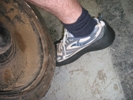
Steel-Toed Assist
Revolutionary rubber safety overshoes. Try saying that fast three times.
- By Vanessa Mays
- Jul 01, 2011
Outfitting an entire workforce with OSHA-compliant steel-toed shoes can be an expensive and time-consuming task for safety managers. While many employers are not required to provide these shoes, it can be a challenge to prove compliance if purchasing the equipment is left up to the worker because there are many cheap, look-alike brands posing as steel-toed boots.
Problems also occur when poor-quality shoes cause injury or pain to the worker. A simple solution would be to allow each employee to choose his or her own shoes, based on preference and fit. But that's not possible -- or is it?
Rubber safety overshoes allow workers to wear their own shoes with a non-slip, steel-toed overshoe covering their favorite pair. This provides a very simple solution to a complicated problem and enables companies to protect temporary workers, office personnel, warehouse employees, and visitors.
For many years, the only overshoes fitting over the entire outer shoe were cumbersome and awkward. While the demand always has existed, it wasn't until recently that advancements were made in the overall design and quality of the rubber safety overshoe. Patrick Smyth saw a need for a differently designed shoe that would work from the freezer to the furnace room, where toe protection was required but often forgotten.
Smyth's invention is an enclosed toe, all-rubber safety overshoe that is a high-quality, cost-effective alternative to expensive safety footwear.
His inspiration came from his enclosed toe design from the sport of curling. Known as "chess on ice," the game is similar to the more widely known shuffleboard and was the key inspiration behind the overshoe. While watching a game of curling in his hometown of Toronto, he noticed the "brushers" in the competition wore an overshoe that was slip-resistant. The players needed a shoe that would allow them to walk and position themselves on the ice and also protect their feet from the cold. From this came the idea for the modern enclosed steel-toe rubber overshoe that fit tightly over regular outer shoes.
In 2006, Smyth tracked down the maker of the shoe. "We weren't inventing the wheel, we were just tweaking it," he explained. He saw a need for a better product and decided to apply it to a mainstream safety overshoe.
Smyth noticed that employees would rather go without protection than wear the old garish and cumbersome black plastic overshoes or the "yellow clackers" that were already in the marketplace.
"When it came to safety compliance on the job, employees found the look comical and often complained about it. Employee acceptance of PPE totally depends on comfort and look factors. If employees don't like wearing a particular piece, they're more likely to do without it," which leads to greater risk of injury, he said.
Smyth had the shoe purpose-designed and engineered to be 4.5 to 6.5 mm thick instead of the 2 to 3 mm thickness of similar products. He placed the steel toe cap inside the shoe and encased it in rubber. "It's designed not to tear, even when cut," he said.
OSHA's general industry foot protection standard states at 1910.136(a), "The employer shall ensure that each affected employee uses protective footwear when working in areas where there is a danger of foot injuries due to falling or rolling objects, or objects piercing the sole, and where such employee's feet are exposed to electrical hazards." The standard goes on to reference ASTM F-2412-2005, Standard Test Methods for Foot Protection; ASTM F-2413-2005, Standard Specification for Performance Requirements for Protective Footwear; ANSI Z41-1999, American National Standard for Personal Protection -- Protective Footwear; and ANSI Z41-1991, American National Standard for Personal Protection -- Protective Footwear, all of which are incorporated by reference in 1910.6.
The overshoe is made of a surface gripping rubber and not PVC, which helps it to last longer and is better for the environment. It meets the ATSM 2413-05 standard and is designed to withstand 200 joules, a measurement of impact incorporating the weight of the object and the distance from which it falls. The standard in the United States is 90 joules.
"The average life span of a steel-toed boot is six months to a year," Smyth said. There is also no transferability with a complete steel-toed shoe. In an economic climate where workers are expected to perform a variety of tasks, an overarching product like this can help to save time and money for applications ranging from offices to warehouses, retail chains, manufacturing plants, and more.
The American workplace is changing. Companies are looking for ways to save money, consolidate, and add value to their bottom line. While cutting corners is not an option when it comes to worker safety, businesses are being forced to adapt and change more aggressively than ever before. Cross-functioning safety overshoes are a great way to remain compliant on a budget.
This article originally appeared in the July 2011 issue of Occupational Health & Safety.